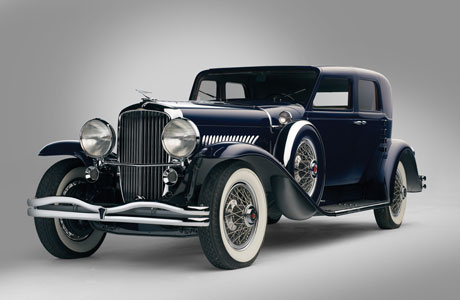SCM Analysis
Detailing
| Vehicle: | 1930 Duesenberg J |
| Number Produced: | 20 Murphy sedans |
| Original List Price: | $12,500 approx. |
| Club Info: | Auburn Cord Duesenberg Club 536 McClean Ave. Staten Island, NY 10305-364 |
| Website: | http://www.acdclub.org |
| Alternatives: | 1930 Cadillac V16 sedan; 1932 Marmon V16 sedan; 1931 Hispano-Suiza J12 sedan |
| Investment Grade: | A |
This car sold for $1,705,000, including buyer’s premium, at RM’s Automobiles of Amelia Island Auction in Amelia Island, Florida, on March 13, 2010.
While Murphy’s convertible coupe is the most common design on Duesenberg chassis, Murphy also produced around 20 sedans, of which 15 have survived. This is probably the best sedan survival rate of any coachbuilder, and is evidence that Murphy was “the coachbuilder for the young at heart.” Their sedan designs-the Beverly, the Berline, the Clear Vision, and four special one-offs-all reflected the Southern California élan.
Following its restoration, this Sport Berline won many awards, including Best in Class, Best Duesenberg, and Best of Show at the 1999 Auburn Cord Duesenberg Festival. Careful maintenance has preserved the restoration.
Look no further than the restoration
Values of Duesenbergs are determined by several traditional factors, but another factor in the generous price achieved here might be that comprehensive restoration.
First, coachwork is everything. Aesthetics rule, because underneath all Model Js is the same chassis. As with most collectible cars, sedans are not at the top of most lists, and many Holbrook, Willoughby, and Judkins sedans were long ago parted out. But the Murphy sedans all had a certain grace, and Hershey’s one-off Sport Berline is very pleasing. Indeed, O’Quinn must have appreciated it; he bought the car at RM’s 2006 Monterey auction for $1.65m.
Second, it is important that a car is original. Cars with all major components, chassis, body, and engine, as they came from the factory, are at the top of the value scale. This car is in that hallowed category, and in fact when it sold in 1998 it was so original that it could have been competently preserved. Even the original, somewhat bilious green paint was still in good condition.
Third, over the last decade, the prices of well-restored Duesenbergs have been growing, and there may be more awareness among older, moneyed collectors that great completed restorations are worth paying for. At Amelia, I talked to two collectors/restorers. One, aged 78, has five unrestored cars and since he spends two years getting one done, he is now facing his own personal time problem.
Another collector in his late 80s, who owns a 1923 Hispano H6B with special coachwork that would be a real hit at Pebble, is considering selling even though most mechanical restoration is done. When asked why he doesn’t finish it, he reminded me that most good restoration shops have at least a three-year waiting list, so time is a problem here as well. Yet another factor is that restoration costs are increasing, both because standards have inflated and shop costs have gone up. Several restorers have mentioned that the chrome plating bill for a J is above $50,000 today. Steve Babinsky, the restorer of the Duesenberg class winner at Amelia this year, confirmed that it costs at least that to achieve the quality and perfection needed for a winner.
So all three factors-coachwork, correctness, and competency of restoration-contribute to the value of this car.
Chris Charlton, the restorer of this Duesenberg in the late 1990s, was at Amelia, and he later provided some insight on his restoration. The catalog implied that the all-aluminum body made the car “nimble,” suggesting that it was light. He pointed out that most Murphy sedans seemed to be lighter than the traditional Model J sedans, but it did not appear that lightness was an objective for this car.
The body had many special aluminum castings, none of which appeared to be designed to save weight. Since Ford had revolutionized car manufacturing with the all-steel body in 1925, perhaps the custom body builders thought it was time to explore an alternative material. But to design the castings and produce them had to be expensive. And since the aluminum skin could not be tacked to a wooden frame, multiple holes were drilled and tapped into the aluminum to allow #4 brass screws to attach the body panels. Thus the aluminum structure became massive and complex. Even securing the upholstery required many holes in the aluminum frame, which were plugged with force-fit wooden plugs so the fabric could be tacked onto the metal frame.
Charlton said that the paint job on this car was one of his best, because the body was originally “flat filed smooth.” All panels were dead flat, with little filler. The Murphy worker’s annoyance was summed up by a pencil scrawl found on an inner panel, “filed, finished, f**k it.” Some panels were filed too thin and required replacement and careful welding, but the results were outstanding and invisible.
So considering the sporting characteristics of Hershey’s design, the all-metal body, the originality of all major components, the complete ownership history, and the careful restoration, isn’t it easier for the SCMer in the audience to just hold that paddle up for five minutes and buy it with one check? All things considered, $1.7m may just have been a decent buy, even at twice the SCM Price Guide numbers.
